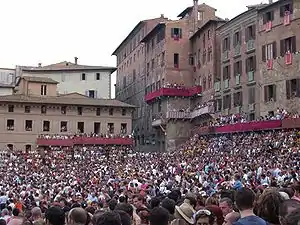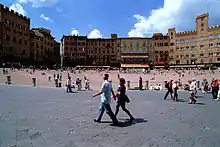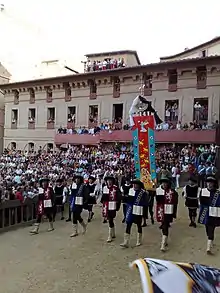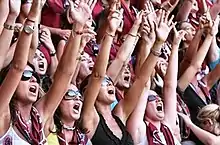锡耶纳赛马节
錫耶納賽馬節(,義大利語發音:[ˈpaːljo di ˈsjɛːna]),於每年的7月2日以及8月16日在義大利錫耶納舉辦的傳統赛马。競賽時,17個區會選出10區進行比賽,一區只能派出一名騎士。競賽規定不能使用馬鞍,騎士穿著的衣服顏色象徵他們所代表的區。在7月2號舉辦的賽馬節被稱為普罗文萨诺賽馬節(Palio di Provenzano),用來紀念普罗文萨诺的瑪丹娜,這是一場特別為了錫耶納的瑪麗亞獻身精神所舉辦的,作為卡莫利亞三分區(Terzo Camollia)的一個象徵。而8月16日舉行的賽馬節則被稱為Palio dell'Assunta,以紀念聖母瑪麗亞的升天。
.jpg.webp)


有時候如果有特殊的事件,例如:地方週年紀念或國家型紀念活動時,被認為是與活動密切相關的城市可能會決定在5月至9月之間舉辦一個非凡的賽馬節。而最近一次的特殊活動舉辦在2000年,以慶祝新世紀的到來。
在比賽前夕舉辦的Corteo Storico是一個盛大的遊行,他吸引了來自世界各地的遊客和觀眾。
比賽時,騎師骑坐无鞍墊的马,在田野廣場進行比賽,廣場上鋪了一層厚厚的泥土。比賽需要跑廣場的三圈,通常賽程不超過90秒。而因為在廣場上常有危險的彎道,所以經常可以看到騎手被甩出賽道,但是,无鞍墊的马在沒有他們的騎手的情況下,獨自完成比賽的情況並不罕見。
歷史
起源
中世紀起,錫耶納在城鎮中心的廣場進行各種競賽。如多人拳擊(pugna)、馬術、鬥牛(16世紀起)等多人競賽。 14世紀起,城市開始有分區參賽的慣例,這類在錫耶納境內舉行的大型競賽開始有palii alla lunga的名稱。比賽之盛大,往往擴及整個城市。
1590年托斯卡尼大公立法禁止鬥牛賽,因此各分區改在田野廣場舉行其他非鬥牛的競賽。一開始是水牛賽(bufalate),後來改為賽驢(asinate), 此時其他地方已開始有賽馬活動出現。1633年始開始有我們現在看到的賽馬(義大利文稱palio alla tonda,有別於早期的palii alla lunga)。[1]
八月賽馬節
一開始,每年只在七月二號舉行一次賽馬。1701年起,第二場賽馬節才偶爾在8月16號舉行。由於8月16號恰逢聖母升天節,因此第二場賽馬節常常被自動歸類為聖母升天節的慶典之一。而之所以會訂在8月16日是因為8月14和15號已經被廣泛認定為聖安東尼日。
八月賽馬節一開始僅作為七月賽馬節的延伸。八月賽馬節通常由七月勝利的分區出資舉行(若該區負擔得起)。1802年後,八月賽馬節改由整個城市出資舉行,不再由分區獨力承擔,八月賽馬節正式成為年年都有的節日。
第一場八月賽馬節舉辦於1581年8月15日。[citation needed]
十七個分區
這十七個分別為:
|
|
|
每一場比賽中, 十七分區中只有十個分區參與:去年未參賽的七個分區,其餘三隊則為抽籤決定。[3]
現今的比賽
第一場比賽於7月2日舉行,既是聖母訪親盛宴,也是當地節日普羅旺斯諾麥當娜的日期。第二場比賽是8月16日舉行的,是聖母盛宴之後的第二場比賽。在特殊事件(例如,阿波羅11號登陸)和重要紀念日(例如義大利統一百週年)之後,西南社區可能決定在5月至9月期間舉行第三次比賽。最近一次是在千禧年(西元2000年)。
比賽僅有十個隊伍,所以並非所有分區皆能上場比賽。去年未參賽的七個分區將優先進入比賽名單,再用抽籤決定其餘三隊。(每年有兩次,分別於五月底及七月初)。 在預備賽結束一年後,私人業主(其中包括一些騎師)為義大利其他賽馬節提供馬廄以供挑選並聘請獸醫為馬匹檢查身體狀況,於比賽前三天決定十個規模相等的馬廄,並以彩票決定哪一批馬代表其分區出賽。將會舉辦六場預備賽用以選擇馬匹,第一場將於傍晚舉行,最後一場則結束於賽馬節開始前的早晨。比賽期間經常生賄賂的情形,促使各分區的選手走會密切注意對手的一舉一動。僅允許雜種馬上場比賽,不能使用純種馬。[4]

The race is preceded by a spectacular pageant, the Corteo Storico, which includes (among many others) Alfieri, flag wavers, in medieval costumes. Just before the pageant, a squad of carabinieri on horseback, wielding swords, demonstrate a mounted charge around the track. They take one lap at a walk, in formation, and a second at a gallop that foreshadows the excitement of the race to come, before exiting down one of the streets that leads out of Piazza del Campo. Spectators arrive early in the morning, eventually filling the centre of the town square, inside the track, to capacity; the local police seal the entrances once the festivities begin in earnest. Seats ranging from simple bleachers to elaborate box seats may be had for a price, but sell out long before the day of the race.
在比賽之前有個壯觀的盛會,古裝遊行,其中包括(在許多其他人中)Alfieri,旗幟揮舞,在中世紀的服裝。 就在賽前,卡賓槍騎兵隊揮舞著劍,在賽道周圍表演衝鋒。 他們步行一圈,形成一秒鐘,另外一個賽道,預示著比賽的興奮,然後退出了出自Piazza del Campo的一條街道。 觀眾清晨到達,最終填補了城市廣場的中心,在軌道內,容納; 一旦慶祝活動開始,當地警方就會密封入口。 從簡單的長椅到精心製作的座椅座椅的座位可能有一個價格,但在比賽當天很久才賣出。
七月賽馬節的下午七點半及八月賽馬節的下午七點,爆炸聲響徹整個廣場,向成千上萬的圍觀者通報了比賽即將開始。比賽將會繞著田野廣場奔跑三圈,the perimeter of which is covered with several inches of dirt and tuff (imported and laid for the occasion at great expense to the city) and the corners of which are protected with padded crash barriers for the occasion. The jockeys ride the horses bareback from the starting line, an area between two ropes. Nine horses, in an order only decided by lot immediately before the race starts, enter the space. The tenth, the rincorsa, waits outside. When the rincorsa finally enters the space between the ropes the starter (mossiere) activates a mechanism that instantly drops the canapo (the front rope). This process (the mossa) can take a very long time, as deals have usually been made between various contrade and jockeys that affect when the rincorsa moves - he may be waiting for a particular other horse to be well- or badly-placed, for example.

在危險的,陡峭的斜坡軌道上,騎士被允許使用他們的鞭子(義大利語, nerbi,拉伸的,乾公牛皮)不僅為自己的馬,而且為了擾亂其他馬和騎士。事實上,是由代表他的對手的馬贏得的,而不是騎師。 獲勝者是穿過終點線的第一匹馬 - 一匹馬可以沒有騎手贏得勝利(一種被稱為cavallo scosso的條件)。 一匹馬也可以沒有它的裝飾頭飾(spennacchiera),雖然相反的信念也被廣泛地持有,甚至在塞內加爾人之間。 比賽中的失敗者被認為是馬匹是第二,而不是最後的對手。
The winner is awarded a banner of painted silk, or palio, which is hand-painted by a different artist for each race. The enthusiasm after the victory, however, is so extreme that the ceremony of attribution of the palio is quite instantaneous, being the first moment of a months-long celebration for the winning ward. There are occasional outbreaks of violence between partisans of rival contrade.
There may be some danger to spectators from the sheer number of people in attendance. There have also been complaints about mistreatment of horses, injuries and even deaths, especially from animal-rights associations and even from some veterinarians. In the Palio held on 16 August 2004, the horse for the contrada of Bruco (the Caterpillar) fell and was badly trampled, as the race was not stopped despite possible additional safety risks for other horses. The horse died of its injuries, raising further complaints from animal-rights organizations.
The Palio differs from "normal" horse races in that part of the game is for the wards to prevent rival contrade from winning. When a contrada fails to win, its historical enemy will celebrate that fact nearly as merrily as a victory of its own, regardless of whether adversarial interference was a deciding factor. Few things are forbidden to the jockeys during the race; for instance, they can pull or shove their fellows, hit the horses and each other, or try to hamper other horses at the start.
The most successful ward is Oca, the Goose, which has won 63 races (at least according to their records, which start from 1644), followed by Chiocciola, the Snail, with 51, and Tartuca, the Tortoise, with 46. Oca is also the contrada with the most wins in recent history (from 1900 to 2010) with 21 victories, followed by Selva, the Forest, with 18, and Drago, the Dragon, with 17.
Among jockeys, the most victorious of all time is Andrea Degortes, nicknamed Aceto ('Vinegar'), with 14 wins (from 1964 to 1996). Angelo Meloni, nicknamed Picino (active from 1897 to 1933) has the second in the number of wins with 13 successes, and Luigi Bruschelli, nicknamed Trecciolino (still active), has the third most of 12 wins (although he claims 13 victories, his horse won without him one year).
The most successful horses were Folco and Panezio with eight wins each, followed by Topolone with seven.
In recent history (from 1900 to the present), only three wards have ever succeeded in winning both the July and the August races in a single year (the term in Italian is fare cappotto). Tartuca (the Tortoise) accomplished the feat in 1933, while Giraffa (the Giraffe) won both races in 1997, with jockey Giuseppe Pes, nicknamed Il Pesse. In 2016, jockey Jonatan Bartoletti, on the mount "Preziosa Penelope", won both the July and August races for Lupa (the She-wolf).[5]
Ritual and rivalry
The Palio di Siena is more than a simple horse race. It is the culmination of ongoing rivalry and competition between the contrade. The lead-up and the day of the race are invested with passion and pride. Formal and informal rituals take place as the day proceeds, with each contrada navigating a strategy of horsemanship, alliances and animosities. There are the final clandestine meetings among the heads of the contrade and then between them and the jockeys.[6] There is the two-hour pageant of the Corteo Storico, and then all this is crowned by the race, which takes only about 75 seconds to complete. Although there is great public spectacle, the passions displayed are still very real.
The contrada that has been the longest without a victory is nicknamed nonna ('grandmother'). Civetta (the Owlet) had the title from 1979 until 2009, when it won 16 August race. Torre (the Tower) had this title for being without victory for 44 years (from 1961 to 2005), and Bruco (the Caterpillar) held the title for not winning over 41 years (from 1955 to 1996). Last nonna was Lupa (the She-Wolf), which has not had a victory since 2 July 1989, a period of 34—35 years, until July 2016, when it finally won, leaving now the nonna title to Aquila (the Eagle).
Palio (Drappellone)

The drappellone ("banner"), or palio, known affectionately as "the rag" in Siena, is the trophy that is to be delivered to the contrada that wins the Palio.
The palio is an elongated rectangular piece of silk, hand-painted by an artist for the occasion. It is held vertically on a black-and-white shaft halberd and topped by a silver plate, with two white and black plumes draped down the sides.
The palio, along with the plumes, remains the property of the contrada. The plate is returned to the city of Siena before the two Palii of the following year, after the date and the name of the victorious contrada are inscribed on its back. There is one silver platter for the Palio in July and another for the August Palio. The plates are replaced approximately every ten years.
The value of the banner is unique, because it represents a particular historical period of the city of Siena. The palii often reflect the symbols of the various governments that have presided at various times, including the crest of the grand duchy of Lorraine, the crest of the Grand Dukes of Tuscany, the crest of the Kingdom of Savoy of Italy, symbols from Fascist Italy, and most recently, imagery of the Republic.
The process that an artist should follow in designing the palio is rigid: it must follow a precise iconography that includes some sacred symbols, as the July Palio is dedicated to the Madonna of Provenzano, and that of August to the Madonna of the Assumption. It must present the insignia of the city, those of the third part of the city,[7] and the symbols or colors of the ten contrade participating in the race. There are, however, no limits regarding the style of the art. The palio is first presented at a press conference in the courtyard of the Podestà of the City Hall about a week before the race.
The Palio runs throughout the year

Although many activities take place within each contrada, the organization of the Palio is still the largest, since it is not just in two races each year. Each time, the festival itself runs for four days of events, the preparation for which lasts all year.
Beginning in early winter, the contrada leaders talk and develop strategies, making contacts with the jockeys and horse owners. These leaders prepare those who will race in the Piazza del Campo or take part in minor Palios elsewhere in nearby towns (la cosiddetta provincia) and bring them to training courses organized by the city in the spring.
The full activities of the Palio start to grow in momentum towards the end of May, with the drawing of lots of the three remaining contrade that will join the seven that have won the right to race. With districts and teams outlined, contrade begin to talk about "deals" (engagement of jockeys) and "parties" (secret pacts for the win), despite not knowing which horse they will draw in the lot.
About a week before the race, the palio (drappellone) itself is presented to the city, which has commissioned a local artist (in the case of the Palio of July) or internationally recognized artist (in the case of the Palio of August or a special Palio) to create the prize. Also at this time, visits occur to the horses which will be presented for the lottery.
In the first of the four days of the festival, the lottery is held to select which barbero (the term for "racehorse" in the city of Siena and Tuscany) will go to which contrada. The stone race track around the square is covered with a layer of dirt composed of a mixture of tuff, clay and sand. Six trials are run, during which the riders have the opportunity to familiarize themselves with their horse and with the track itself, its sounds and rhythms of the race. Although the trials are attended by many tourists and contrada members in square, barriers are mounted on the outside of the track.
Among the events that mark the approach of the Palio are the rehearsal dinner, the "mass" of the jockeys and the blessing of the horse and jockey.
Extraordinary Palios
An extraordinary Palio is a third Palio which may take place during the period between May and September and is associated with events or anniversaries of major importance for the community of Siena. The last extraordinary Palio coincided with the advent of the new millennium. It was actually held on 9 September 2000 and was won by Selva (Forest), by jockey Giuseppe Pes riding on the horse Urban II. Prior to this, the last extraordinary Palio was held on 13 September 1986 to celebrate the centenary of the abolition of the Balia and Biccherna governments.
In earlier times, the third Palio was a way to honor distinguished guests passing through or visiting Siena. Examples are the extraordinary Palio of 7 June 1676, during the visit to Siena of the wife of Prince Don Agostino Chigi, and that of 15 June 1673 (not considered official), honouring the visit to Siena of Cardinal Flavio Chigi. Even the Grand Duke of Tuscany requested another round of Palio, perhaps closer to the ordinary.
From the second half of the 19th century, extraordinary Palios began to be organized for celebration of special events, rather than illustrious visits. This was the case of a meeting of the Society of Sciences or the inauguration of important monuments (such as the inauguration of the monument to the fallen in the Battle of Curtatone and Montanara, on 29 May 1893). In 1896, they even ran four Palios, both ordinary and two extraordinary. The first extraordinary race was on 16 August, which is considered extraordinary because it was requested by the citizens as the original race was moved to 25 August due to transfer from Siena's VIII Corps, and the second was on 23 September for the inauguration of the monument to Giuseppe Garibaldi.
A third Palio, the "Palio of Peace", was held in 1945 by popular acclaim to celebrate the end of World War II and was won by Gioacchino Calabro riding Rubacuori su Folco, for the contrada of Drago (Dragon). An extraordinary Palio was held in 1969 to commemorate the conquest of the moon by the Apollo 11 mission.
The following years created the habit of running on the occasion of a centenary of particular importance. This is the case for 28 May 1950, the fifth centenary of the canonization of St. Bernardine of Siena, and 5 June 1961, the centenary of the Unification of Italy.
各分區獲勝統計
| 分區 | 獲勝總數 | 十七世紀 | 十八世紀 | 十九世紀 | 二十世紀 | 二十一世紀 | 近期獲勝的日期 |
|---|---|---|---|---|---|---|---|
| 24 | 0 | 7 | 6 | 11 | 0 | 1992年7月3日 | |
| 37 | 6 | 7 | 16 | 5 | 3 | 2008年8月16日 | |
| 51 | 4 | 19 | 14 | 14 | 0 | 1999年8月16日 | |
| 33 | 2 | 7 | 15 | 8 | 2 | 2014年8月16日 | |
| 37 | 2 | 8 | 10 | 15 | 2 | 2014年7月2日 | |
| 35 | 3 | 5 | 9 | 15 | 2 | 2011年8月16日 | |
| 41 | 4 | 11 | 14 | 10 | 2 | 2008年7月2日 | |
| 30 | 3 | 3 | 11 | 11 | 2 | 2007年8月16日 | |
| 36 | 1 | 11 | 11 | 11 | 2 | 2016年8月16日 | |
| 42 | 5 | 10 | 12 | 15 | 0 | 1998年8月16日 | |
| 65 | 8 | 14 | 20 | 20 | 3 | 2013年7月2日 | |
| 39½ | 4 | 9½ | 14 | 11 | 2 | 2013年8月16日 | |
| 26 | 3 | 6 | 7 | 9 | 1 | 2006年7月2日 | |
| 38 | 2 | 11 | 6 | 15 | 4 | 2015年8月17日 | |
| 47½ | 4 | 11½ | 16 | 12 | 4 | 2010年8月16日 | |
| 45 | 6 | 12 | 20 | 5 | 2 | 2015年7月2日 | |
| 44 | 2 | 16 | 10 | 15 | 1 | 2012年8月16日 | |
| 總計 | 661 | 59 | 167 | 211 | 202 | 32 | [8] |
馬匹安全之爭議
幾年來,錫耶納賽馬節一直是動物權益組織抗議活動的焦點,其中包括反活體解剖聯盟。主要原因是比賽造成的跌倒經常導致了馬的死亡。
這些擔憂導致了意大利旅遊部部長在2011年阻止錫耶納賽馬節被提名為聯合國教科文組織 非物質文化遺產名錄。[9]
根據反活體解剖聯盟統計,1970至2007年共有48匹馬因錫耶納賽馬節而死亡,[10] 然而,賽馬節的支持者指出,因錫耶納賽馬節而死亡的馬匹死亡數量僅有交通事故死亡的2.05%。[11] 自90年代以來,制定和執行了許多關於動物保護的規定,賽馬節的支持者強調自那時以來,馬匹受傷情形已經大大減少。
近幾十年來,錫耶納市採取了一系列措施,確保馬匹(和騎手)在比賽進行期間的安危,但這些措施仍然被一些動物福利團體判斷不足,他們繼續要求廢除比賽,所採取的措施包括:
- Approval in 1999 the "Protocol for the provision of incentives for the maintenance of the Palio horse" and the establishment of the register of horses trained to run. A register of farmers was introduced in 2004, instead of half blood Arabian horses (deemed physically fit to travel) and a register of barriers[14]
- Building a track in the town of Mociano, identical in shape and slope to the Piazza del Campo. From March to June, in addition to Monticiano and Monteroni d'Arbia, the horses intended for the Palio train here.[15]
- Protections (formerly known as materassoni) present the curve of St. Martin in June 1999 set up a barrier of protection to high absorption in PVC, raising the parapet of the House and the curve of shirts introduction of safety for the emergency personnel of 118,[15]
- Intervention on the composition, method of implementation and monitoring of the layer of tuff[15]
- Care of horses that no longer run the Palio (due to age or injury) at the Equestrian Center of State Forestry, "The Caggio", in the town of Radicondoli.[16]
- Alcohol test for jockeys[17] by order of the Secretary of Health Francesca Martini.[18]
圖庫
 田野廣場擠滿了人群
田野廣場擠滿了人群.jpg.webp) 賽馬進入田野廣場
賽馬進入田野廣場 工作人員於比賽開始前將繩索繫緊
工作人員於比賽開始前將繩索繫緊.jpg.webp) 所有參賽者被要求在比賽前待在被分配的區域內。
所有參賽者被要求在比賽前待在被分配的區域內。.jpg.webp) 當最後一批馬進入賽場,比賽即開始。
當最後一批馬進入賽場,比賽即開始。.jpg.webp) 於2006年8月16日舉辦的錫耶納賽馬節開賽。
於2006年8月16日舉辦的錫耶納賽馬節開賽。.jpg.webp) 2006年8月16日Alberto Ricceri對所屬的森林區獲勝感到欣喜。
2006年8月16日Alberto Ricceri對所屬的森林區獲勝感到欣喜。.jpg.webp) Jonatan Bartoletti在獲勝後親吻他的座騎Brento。
Jonatan Bartoletti在獲勝後親吻他的座騎Brento。
相關電影
能在以下的電影看見有關錫耶納賽馬節的內容:
- Palio by Alessandro Blasetti (1932)
- La ragazza del Palio by Luigi Zampa (1957)
- Bianco rosso celeste – cronaca dei giorni del Palio di Siena by Luciano Emmer (1963)
- "The Winds Rise", the first episode of the 1983 miniseries The Winds of War, ABC miniseries directed by Dan Curtis
- Il bianco e il nero – Tutti i colori del Palio di Siena by Anton Giulio Onofri (2002)
- The Last Victory by John Appel (2004)
- Visioni di Palio by Anton Giulio Onofri (2004)
- Piazza delle Cinque Lune by Renzo Martinelli (2006)
- Quantum of Solace, the 22nd James Bond movie, directed by Marc Forster (2008)
- Palio by Cosima Spender and John Hunt (2015)
參考資料
- . Ilpalio.org. [15 September 2016]. (原始内容存档于2017-04-20).
- The contrada of Valdimontone, although its colors are yellow, red and white, has a habit of taking the prize for the jockey jacket with yellow and pink. This custom, reported since the 18th century, was formalized in 1833, to avoid confusion with contrada of Chiocciola, whose colors (yellow, red and blue) are almost identical.
- . Il Palio.Siena .it. [19 June 2012]. (原始内容存档于2014-12-23).
- . Ilpalio.org. [19 June 2012]. (原始内容存档于2017-04-12).
- . [2017-04-22]. (原始内容存档于2017-03-31).
- . [21 September 2009]. (原始内容存档于2009-05-17).
- Terzi (Siena)
- . Ilpalio.org. [19 June 2012]. (原始内容存档于2017-05-28).
- . [2017-04-27]. (原始内容存档于2017-04-27).
- Il palio di Siena (页面存档备份,存于) dossier della Lega Anti Vivisezione
- (PDF). [19 June 2012]. (原始内容 (PDF)存档于2012-03-12).
- cf. Regulation of the Palio (Chapter IV – The submission, selection and award lots of horses) Article 37: The horses to be presented must, in the days immediately preceding the question on the written request of owners, undergo a visit by a Veterinary Commission, which must express opinion on health at the races in "Campo".
- cf. Regulation of the Palio (Cap.V, testing and racing jockeys) .57 Article: It is prohibited to administer their peers in any way, intoxicating, practice clutches of any kind, or apply "Perette.
- This project aims to achieve: the accreditation of the owners, after verification of appropriate conditions, the selection of horses with common features of the biometric considered optimal for the commitment to be addressed; training of subjects in competitions and training courses to order to optimize the preparation and adaptability to the location of the Palio, the implementation of a system of economic incentives for owners to address the purchase and breeding of horses with shared characteristics, the constant monitoring of animals by veterinarians being the Regulatory Commission Technical Hall. See also Rendiconto Giunta Cenni 2001-2006, pag.275
- cfr. Board of Work Statement, cit.
- Campioni al pascolo, di Gianni Perotti (页面存档备份,存于) – Famiglia Cristiana page 33 14 August 2005 questo reportage Archive.is的存檔,存档日期2005-01-20 The Breeding Center of wilderness.
- . Style.it. [19 June 2012]. (原始内容存档于2012年7月22日).
- . Normativasanitaria.it. [19 June 2012]. (原始内容存档于2012-03-12).
參考文獻
- Brown, Margaret Mcdonough and Titus Buckhardt (1960). Siena, the City of the Virgin. Oxford: Oxford University Press.
- Drechsler, Wolfgang (2006). "The Contrade, the Palio and the Ben Comune: Lessons from Siena", Trames 10(2), 99-125. (页面存档备份,存于)
- Dundes, Alan and Alessandro Falassi (2005). La Terra in Piazza. An Interpretation of the Palio of Siena. 2 the new edn. (Orig. 1972). Siena: Nuova Immagine. (Standard work, but meanwhile very controversial because of its Freudian interpretation.)
- Falassi, Alessandro (1985). "Palio Pageant: Siena's Everlasting Republic", The Drama Review 29(3), 82-92.
- Handelman, Don (1998). Models and Mirrors: Towards an Anthropology of Public Events. Cambridge: Cambridge University Press.
- Silverman, Sydel (1979). "On the Use of History in Anthropology: The Palio of Siena", American Ethnologist 6(3), 413-436. (Most important counter-model to Dundes & Falassi.)
- Pascal, C. Bennett (1981). "October Horse", Harvard Studies in Classical Philology 85, 261-291.
- Spicer, Dorothy Gladys (1958). Festivals of Western Europe. Wilson.
- 1911 Encyclopædia Britannica, "Siena".
- Il Palio di Siena website - English Summary.
參見
- Ansano "Ansanello" Giovannelli
- Bravio delle botti of Montepulciano
外部連結
- The Palio (页面存档备份,存于) (英文) The definitive English language site for all Palio Di Siena related information
- Archive of the Palio di Siena I (页面存档备份,存于) (意大利文) The Italian archive site includes access to short contemporary films of the Palio for 1930 and most subsequent years.
- Archive of the Palio di Siena II (页面存档备份,存于) (英文)
- History of the Race (页面存档备份,存于) (意大利文) (英文)
- Siena - Map It Out! (页面存档备份,存于) (英文) How to Survive a Day at the Palio
- How to be more than a spectator (英文)
Template:Siena landmarks